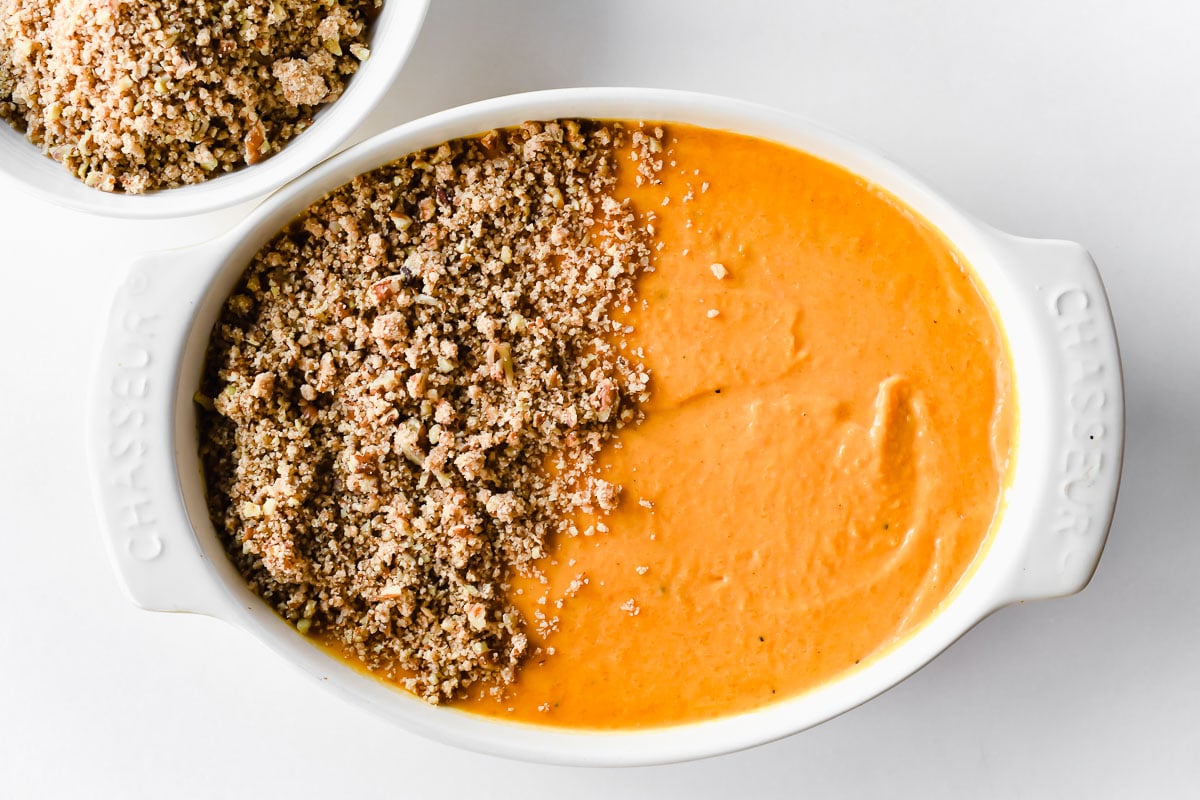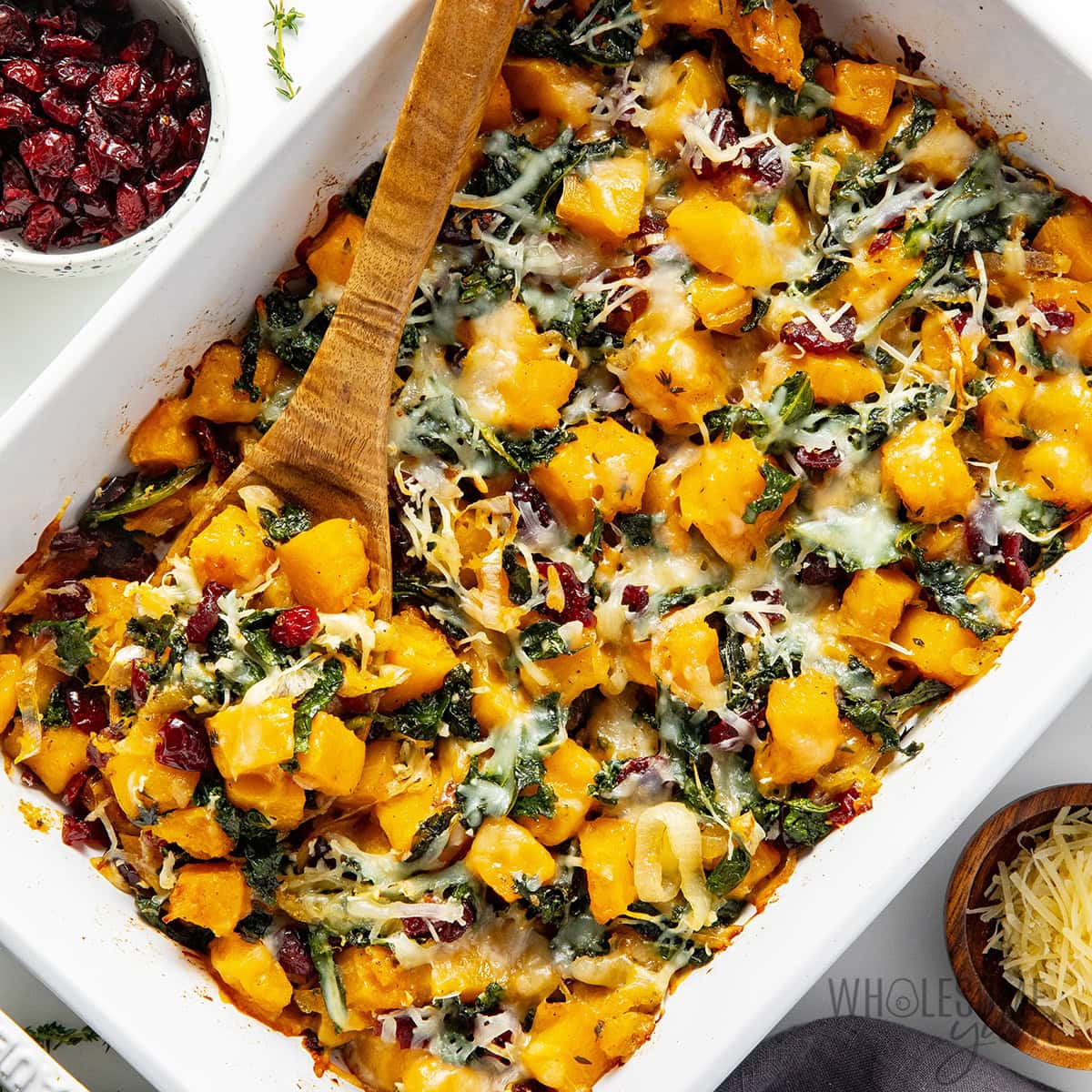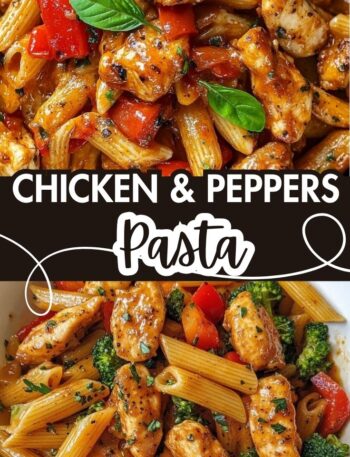
Butternut Squash Casserole is a comforting, flavorful dish that combines the natural sweetness of roasted butternut squash with creamy textures and warm, savory spices. Often enhanced with ingredients like cheese, breadcrumbs, nuts, or a hint of maple syrup, this casserole is both hearty and nutritious.
It’s a popular side dish during the fall and winter months, especially around Thanksgiving and other holiday gatherings. Its rich flavor and smooth consistency make it a family favorite, while its versatility allows for both sweet and savory variations. Perfect for cozy dinners, this casserole adds warmth and color to any table.
A warm and comforting Butternut Squash Casserole is the perfect side dish or vegetarian main for autumn dinners, Thanksgiving feasts, or any time you’re craving cozy, nourishing food.
The creamy texture of butternut squash, combined with savory herbs, a touch of sweetness, and a crispy topping, makes this casserole both satisfying and wholesome.
Butternut Squash Casserole: An Incredible Ultimate Recipe for Everyone
Description
Butternut Squash Casserole is a comforting, creamy, and savory-sweet dish perfect for fall and winter gatherings.
Roasted or steamed butternut squash is mashed and blended with butter, cream, and warm spices like cinnamon and nutmeg.
Topped with a buttery breadcrumb or pecan streusel topping, this casserole bakes until golden and bubbly. It pairs well with roasted meats or can stand alone as a vegetarian main.
Its velvety texture and subtle sweetness make it a family favorite during holiday feasts. This dish delivers cozy seasonal flavor with minimal effort, making it ideal for both weeknight dinners and special occasions.
Ingredients
For the Topping:
Instructions
-
Begin by peeling the butternut squash with a vegetable peeler, then halve it lengthwise and scoop out the seeds. Cut the flesh into 1-inch cubes. You should have about 4–5 cups of cubed squash.
-
Place the squash in a large saucepan, cover with water, and bring to a boil. Reduce the heat and simmer for 10–12 minutes, or until the squash is fork-tender. Drain well and let it cool for a few minutes. Alternatively, you can roast the squash: drizzle the cubes with olive oil, spread on a baking sheet, and roast at 400°F (200°C) for 25–30 minutes until soft and slightly caramelized.
-
While the squash cooks, heat olive oil or butter in a skillet over medium heat. Add the chopped onion and sauté for 5–7 minutes until soft and translucent. Add the minced garlic and cook for another 1 minute, just until fragrant. Remove from heat and set aside.
-
In a large mixing bowl, mash the cooked squash using a potato masher or blend it in a food processor for an ultra-smooth consistency. Add in the sautéed onion and garlic, milk or cream, sour cream (or Greek yogurt), eggs, salt, pepper, nutmeg, thyme, and cinnamon (if using). Mix well until smooth and evenly combined. Taste and adjust seasoning as needed.
-
Preheat your oven to 375°F (190°C). Lightly grease a 2-quart baking dish with butter or non-stick spray. Pour the squash mixture into the prepared baking dish and spread it out evenly with a spatula.
-
In a small bowl, mix together the panko breadcrumbs (or cracker crumbs), melted butter, and Parmesan cheese (if using). Sprinkle the topping evenly over the casserole.
-
Place the casserole dish in the preheated oven and bake uncovered for 40–45 minutes, or until the top is golden brown and the edges are bubbling slightly. If you want a crispier topping, broil for the last 2–3 minutes—just keep a close eye to avoid burning.
-
Let the casserole cool for 5–10 minutes before serving. Garnish with chopped fresh parsley for a touch of color and freshness. Serve warm as a side dish or as a vegetarian main with salad or bread.
Nutrition Facts
Servings 8
- Amount Per Serving
- Calories 250kcal
- % Daily Value *
- Total Fat 14g22%
- Saturated Fat 6g30%
- Cholesterol 40mg14%
- Sodium 400mg17%
- Total Carbohydrate 35g12%
- Dietary Fiber 6g24%
- Sugars 14g
- Protein 6g12%
* Percent Daily Values are based on a 2,000 calorie diet. Your daily value may be higher or lower depending on your calorie needs.
Note
Butternut squash casserole is a comforting, wholesome dish that blends the natural sweetness of squash with creamy, savory, or even crunchy elements.
Whether you're serving it for a holiday feast or a cozy weeknight dinner, getting it just right involves a few clever tips and thoughtful serving tricks. Here's everything you need to know to make your casserole not just good—but unforgettable.
Cooking Tips for Perfect Texture and Flavor
1. Roast the Squash First (Don't Boil!):
Roasting the butternut squash intensifies its flavor and keeps it from becoming watery. Cube the squash, toss it with a bit of olive oil, and roast at 400°F (200°C) for about 25–30 minutes until caramelized and soft. Roasting also reduces moisture content, preventing a soggy casserole.
2. Use a Flavor Base (Aromatics Matter):
Start your casserole with a base of sautéed onions, garlic, or shallots. Adding herbs like thyme, sage, or rosemary enhances depth. A pinch of nutmeg complements the natural sweetness of butternut squash beautifully.
3. Balance the Sweetness:
Butternut squash is naturally sweet, so counter it with savory ingredients. Adding cheese (like sharp cheddar, parmesan, or gruyère) brings saltiness and umami, while a touch of cayenne or black pepper adds gentle heat.
4. Add Creaminess Without Overdoing It:
Many recipes use heavy cream or sour cream to create a rich base, but you can substitute Greek yogurt for a lighter version. Alternatively, blend roasted squash with milk and eggs to make a smooth custard-like base without excess fat.
5. Texture Is Key—Add Crunch:
To elevate the casserole, top it with a crunchy layer. Try a mix of breadcrumbs, crushed crackers, or even chopped pecans combined with a bit of melted butter and herbs. Bake until golden for a textural contrast that keeps every bite interesting.
Serving Tricks to Impress Every Time
1. Bake in Individual Ramekins for Elegance:
Instead of using one large dish, portion the casserole into individual ramekins or mini cocottes. It creates an upscale presentation and makes serving easier, especially for dinner parties or potlucks.
2. Garnish Right Before Serving:
Brighten up your casserole just before serving with a sprinkle of fresh herbs like parsley or chives. You could also drizzle a little maple syrup or balsamic glaze for a touch of sophistication.
3. Pair It Thoughtfully:
Butternut squash casserole pairs well with roasted meats, grilled chicken, or pork tenderloin. For vegetarians, serve it alongside a kale salad with cranberries and walnuts, or a lentil dish for added protein.
4. Keep It Warm the Smart Way:
Use an oven-safe serving dish or a warming tray to keep your casserole hot during meals or gatherings. If using a buffet setup, a slow cooker set to "warm" can help maintain temperature without drying it out.
5. Double the Recipe, Half the Trouble:
This casserole freezes beautifully. If you're already making one batch, double it and freeze the extra in a disposable aluminum pan. You’ll thank yourself later when you need a quick meal or holiday side.
Serving Size and Storage
A typical 9x13-inch casserole yields about 8 to 10 servings. If you're serving a crowd, it’s smart to plan for extra—it tends to be popular, and leftovers are gold.
- Leftovers Storage Tip: Let the casserole cool completely before covering and refrigerating. It keeps well for up to 4 days in the fridge or 2–3 months in the freezer.
- Reheating Tip: Reheat in the oven at 350°F (175°C) for 15–20 minutes to maintain its texture, rather than microwaving (which can make it soggy).
Serving Suggestions:
This butternut squash casserole pairs wonderfully with:
- Roasted meats (turkey, chicken, or pork)
- Holiday side dishes like cranberry sauce, stuffing, or green beans
- Fresh arugula or kale salad
- Crusty artisan bread
Variations:
- Sweet Version: Add 2 tablespoons of maple syrup or brown sugar to the squash base. Skip the garlic/onion, and add 1/2 teaspoon of cinnamon and a pinch of cloves. Top with crushed pecans and a bit more brown sugar for a sweet holiday twist.
- Cheesy Option: Mix 1/2 cup shredded sharp cheddar or gruyère into the squash before baking for a creamy, cheesy upgrade.
- Gluten-Free: Use gluten-free breadcrumbs or omit the topping altogether and sprinkle with chopped nuts instead.
- Vegan: Use plant-based milk, skip the eggs (or use a flax egg), and replace sour cream with vegan yogurt. Use olive oil in the topping and omit cheese.
Make-Ahead & Storage:
- Make-Ahead: Assemble the casserole (without baking) up to 24 hours in advance and store covered in the refrigerator. Add topping just before baking.
- Storage: Store leftovers in an airtight container in the fridge for up to 4 days.
- Freezing: The baked casserole freezes well. Cool completely, wrap tightly, and freeze for up to 2 months. Thaw overnight in the fridge and reheat in a 350°F oven.
The Perfect Canvas for Comfort
Butternut squash serves as nature's ideal casserole base, offering a naturally sweet, nutty flavor that pairs beautifully with both savory and sweet elements. When roasted and mashed, it creates a silky foundation that rivals traditional potato-based casseroles while providing significantly more nutrition. The squash's natural creaminess means less dairy is needed to achieve that luxurious texture everyone craves in a perfect casserole.
The vibrant orange color creates an immediately appealing presentation that brightens any dinner table. Unlike pale, beige casseroles that blend into the background, butternut squash casserole commands attention and promises the comfort food satisfaction that makes special meals memorable.
Universal Appeal Through Versatility
What makes this recipe truly ultimate is its remarkable ability to satisfy diverse dietary preferences and restrictions. The base recipe easily adapts to vegan preparations using plant-based milk and butter alternatives, while still maintaining its rich, satisfying character. For those following gluten-free diets, it naturally contains no wheat while delivering the hearty satisfaction typically associated with grain-based casseroles.
Traditional versions might include a crispy breadcrumb or nut topping that adds textural contrast, while health-focused variations could incorporate quinoa or wild rice for added protein and fiber. Sweet variations might include maple syrup and warming spices like cinnamon and nutmeg, while savory versions could feature fresh herbs, garlic, and parmesan cheese.
Seasonal Celebration on Every Table
Butternut squash casserole shines particularly bright during fall and winter months when the squash is at its peak flavor and availability. It's become a staple at Thanksgiving tables, offering a sophisticated alternative to traditional sweet potato casserole while providing similar comfort food appeal. The dish's elegant appearance makes it suitable for formal holiday dinners, yet its comforting nature works perfectly for casual family meals.
The make-ahead friendly nature of this casserole makes it invaluable for holiday entertaining. It can be assembled days in advance, refrigerated, and baked when needed, freeing up precious oven space and preparation time during busy holiday cooking sessions.
Nutritional Powerhouse in Disguise
Beyond its incredible taste, butternut squash casserole delivers impressive nutritional benefits that make everyone feel good about indulging. The squash provides vitamin A, fiber, potassium, and antioxidants while maintaining the satisfying richness that makes casseroles so beloved. It's naturally lower in calories than many traditional casserole options while being more nutrient-dense.
This ultimate recipe proves that the most successful comfort foods are those that honor both our nutritional needs and our emotional desire for satisfying, warming meals that bring people together around the table in celebration of good food and good company.
Final Note:
Whether you're hosting a holiday dinner or preparing a hearty weeknight side, this Butternut Squash Casserole delivers comfort, flavor, and versatility.
Its creamy texture and golden topping make it a crowd-pleaser that’s easy to customize and prepare ahead of time. Warm, earthy, and nourishing—this is fall in a dish.
Final Thought
With its velvety texture and warming flavors, butternut squash casserole is a seasonal favorite worth perfecting.
By applying these simple tips and tricks—roasting the squash, layering flavors, adding crunch, and presenting it creatively—you’ll turn a humble dish into a showstopper that steals the spotlight at any meal.
Frequently Asked Questions
Can I make butternut squash casserole ahead of time?
Yes! Butternut squash casserole is an excellent make-ahead dish. You can fully assemble it a day in advance, cover it tightly, and refrigerate until ready to bake. When you're ready, let it sit at room temperature for 20–30 minutes, then bake as directed. You can also bake it completely, refrigerate, and reheat before serving.
How do I prepare the squash—should it be roasted, boiled, or steamed?
For the best flavor and texture, roasting is preferred. Roasting brings out the squash’s natural sweetness and gives the casserole a deeper, richer taste. However, boiling or steaming works if you're short on time. Just make sure the squash is fully tender before mashing or blending it into the casserole base.
Can I make it dairy-free or vegan?
Absolutely. To make it dairy-free or vegan, substitute the butter with a plant-based alternative, and use non-dairy milk (like oat or almond). Replace any cheese or cream with vegan alternatives. If the recipe includes eggs, a flaxseed egg (1 tbsp ground flax + 2.5 tbsp water) can be used as a binder in most versions.
What can I serve with butternut squash casserole?
It pairs beautifully with holiday meats like roast turkey, ham, or chicken, but it also works well with vegetarian mains like stuffed mushrooms or lentil loaf. Add a crisp green salad or roasted Brussels sprouts to balance the creamy richness of the casserole.








